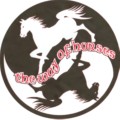
THE WAY OF HORSES |


Copyright © thewayofhorses
Eleanor
Richards |
INTERPRETING
FEED
TAGS By Eleanor Richards Copyright © 2004 |
Fiber Fiber-you know how important it is for you - well, it is even more important for your horse. A feed tag will list the percentage of fiber which may be as low as 3% or as high as 25 per cent. But, what do these numbers tell us? The digestive system of the horse is designed to digest fiber - in the form of forage (hay or pasture). They have a very small stomach and a very large hind gut. The cecum (part of the hind gut) is where long-stemmed fiber is digested. It is a fermentation vat. So, based on the knowledge that horses need a high fiber diet you would think the higher the percentage of fiber, the better the feed. But, like most things related to nutrition it is not that easy. How digestible is the fiber source? Is the feed designed for the nutritional needs of the individual? There are several ingredients used in feed as fiber sources. Some of these ingredients are also used as inexpensive "filler", which do nothing for the horse nutritionally, but do keep the cost of the feed down (per bag, not per meal.) Keep in mind these ingredients are not considered to be long-stem fiber. Sources of long-stem fiber are hay, pasture, alfalfa cubes (not pellets) and chopped hay. The Acid Detergent Fiber (ADF) rating tells us how digestible the fiber is in a feed source. Here is a list of some of the popular fiber sources in feed; the higher the ADF the lower the digestibility. INGREDIENT CRUDE FIBER ADF Wheat Middlings 9.5% 11-13% Rice Bran 14.0% 18-20% Beet Pulp 20.0% 20-25% Oat Hulls 33-36% 36-40% Soy Hulls 11-13% 46-54% As you study this chart you will notice just because the crude fiber percentage is high does not mean the horse will be able to utilize the fiber. Beet pulp and rice bran would be the best choices for fiber in a premium horse feed formula…but the most expensive. You get what you pay for. Wheat middlings are a good choice, but the crude fiber level is low, even though the ADF is excellent. If the feed formula contains a large quantity of oat hulls or soy hulls the recommended feeding rate per day will be higher than a product that contains more digestible ingredients. Yes, the product will be inexpensive to purchase per bag, but you will have to feed more to meet the nutritional needs of a horse. For example: There is a feed on the market that sells for $5.00 per 50 pounds. The feeding recommendation in pounds per day for an adult 1,000-pound horse at maintenance activity level is 1.5 (1 ˝) percent of his body weight. Fifteen pounds of this product needs to be fed each day to meet the nutritional requirements of this horse. Do the math: This feed costs 10 cents per pound. Fifteen pounds times 10 cents equals $1.50. So it will cost $1.50 each day to feed this horse. (One note: you never want to feed a 1,000-pound horse more than 5 pounds at one feeding, so that means you will need to feed 3 times a day.) Now let's look at a premium horse feed. This product costs $10.00 per 50 pound bag. The feeding recommendation for the same horse is .5 (˝) percent of his body weight. Five pounds of this product needs to be fed each day to meet the nutritional requirements for a 1,000-pound horse at maintenance level. Let's do the math: This feed costs 20 cents per pound. Five pounds times 20 cents equals $1.00. It will cost you $1.00 per day to feed the same horse a better and safer product. Less feed means less chance of overloading the digestive system with carbohydrates and starch that can lead to colic and founder. The information above pertains to feed formulas designed to be fed with hay or pasture. Complete feeds that contain the forage, such as a senior product, have high feeding recommendations and a high crude fiber percentage. These meals must spread throughout the day. The complete feeds are providing both the forage and the nutrients. Never feed a horse more than .5 percent of his body weight in one meal. The best way to feed a horse is small frequent meals. Click here to read the next column: Feed Tag - Minerals |